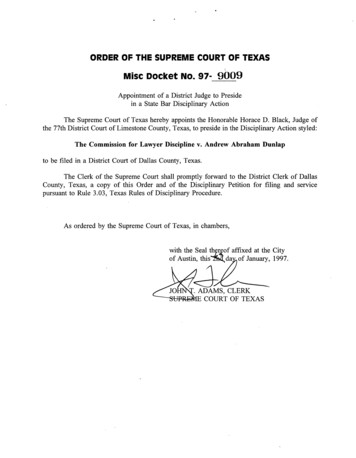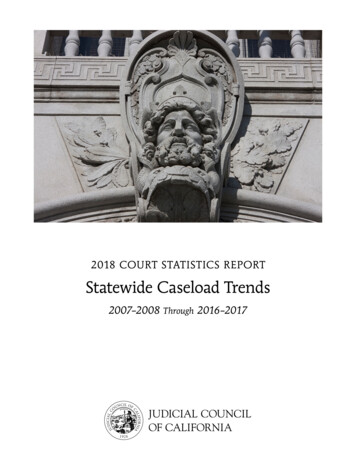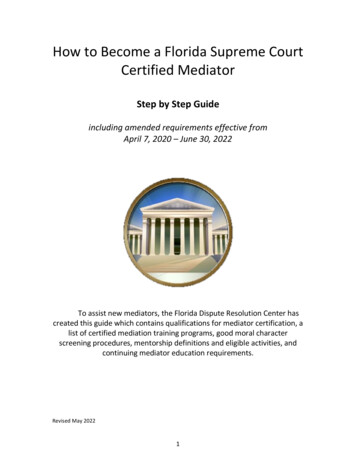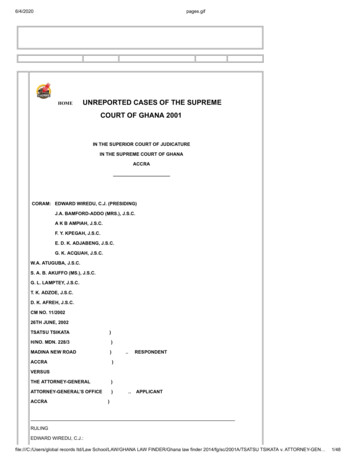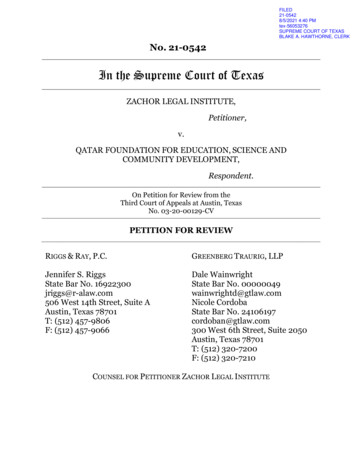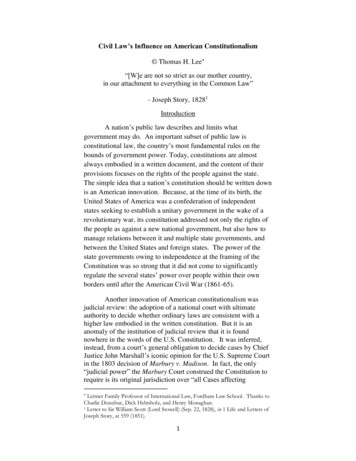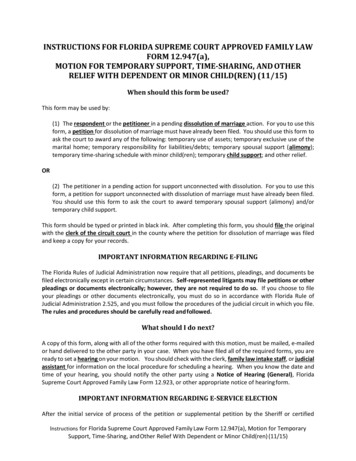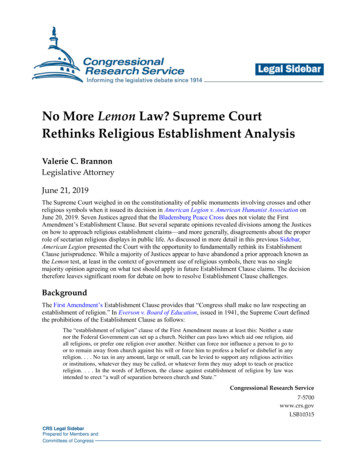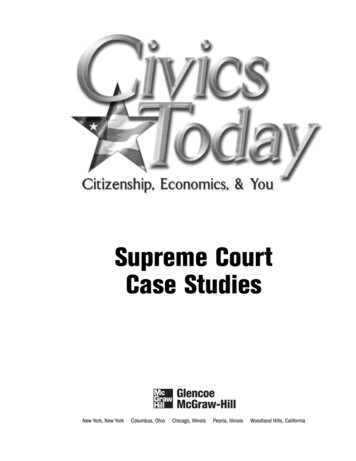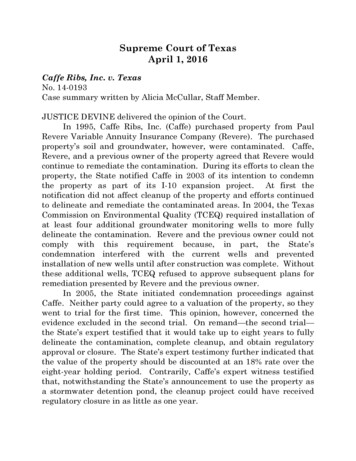
Transcription
Supreme Court of TexasApril 1, 2016Caffe Ribs, Inc. v. TexasNo. 14-0193Case summary written by Alicia McCullar, Staff Member.JUSTICE DEVINE delivered the opinion of the Court.In 1995, Caffe Ribs, Inc. (Caffe) purchased property from PaulRevere Variable Annuity Insurance Company (Revere). The purchasedproperty’s soil and groundwater, however, were contaminated. Caffe,Revere, and a previous owner of the property agreed that Revere wouldcontinue to remediate the contamination. During its efforts to clean theproperty, the State notified Caffe in 2003 of its intention to condemnthe property as part of its I-10 expansion project. At first thenotification did not affect cleanup of the property and efforts continuedto delineate and remediate the contaminated areas. In 2004, the TexasCommission on Environmental Quality (TCEQ) required installation ofat least four additional groundwater monitoring wells to more fullydelineate the contamination. Revere and the previous owner could notcomply with this requirement because, in part, the State’scondemnation interfered with the current wells and preventedinstallation of new wells until after construction was complete. Withoutthese additional wells, TCEQ refused to approve subsequent plans forremediation presented by Revere and the previous owner.In 2005, the State initiated condemnation proceedings againstCaffe. Neither party could agree to a valuation of the property, so theywent to trial for the first time. This opinion, however, concerned theevidence excluded in the second trial. On remand—the second trial—the State’s expert testified that it would take up to eight years to fullydelineate the contamination, complete cleanup, and obtain regulatoryapproval or closure. The State’s expert testimony further indicated thatthe value of the property should be discounted at an 18% rate over theeight-year holding period. Contrarily, Caffe’s expert witness testifiedthat, notwithstanding the State’s announcement to use the property asa stormwater detention pond, the cleanup project could have receivedregulatory closure in as little as one year.
The State moved to exclude Caffe’s expert testimony claiming thatthe testiomy was both unreliable and amounted to a claim for“announcement damages.” The trial court granted the State’s motionholding that exclusion was required by the “project influence rule.”Despite attempts to proffer testimony concerning the State’s role indelaying the property’s remediation, the trial court allowed mere briefsummaries of the testimony and sustained the State’s objections to oraltestimony on the subject. The court of appeals affirmed the trial court’sexclusionary holding stating, “even if the trial court abused itsdiscretion in excluding [Caffe’s experts’] proffered testimony, theexclusion was harmless.”ISSUE: Did the trial court abuse its discretion by excludingevidence concerning the government’s role in delaying a condemnedproperty’s environmental cleanup prior to taking?Because the trial court, under the project-influence rule, excludedthe testimony, the Court began its analysis by defining the projectinfluence rule. Impending condemnation can impact the market valueof property in one of two ways: an inflationary effect (projectenhancement) or a deflationary effect (condemnation blight). Theproject-influence rule is intended to remove these components from theproperty’s market-value determination. Thus, any change in value,following a government announcement intending to take the property,must be excluded from an adequate award of compensation. The Courtruled that the use of an evidentiary exclusion to prevent the distortingeffect of the project on the market value of the property is not proper. Aproper jury instruction allowing the jury to account for the result of theState’s condemnation, instead, produces compensation that serves thepurpose of the project-influence rule. Therefore, the Court held that thetrial court abused its discretion when it excluded the expert testimony.Additionally, the Court found that Caffe sought to recover thehypothetical price of the property on the date of the State’s de juretaking and distinguished this case from its prior holding in Westgate.Without direct restriction on the use of property, targeting property forcondemnation does not result in a de facto taking. Since Caffe did notassert that the condemnation announcement amounted to a de factotaking, the State’s reliance on Westgate was misplaced. Also, the Statecontended that Caffe’s expert testimony was unreliable because itcontradicted proven facts. The Court stated that an expert’s testimony
is unreliable only if it contradicts actual, undisputed facts. Caffe’sexpert testimony, at least, shows that the State bears someresponsibility for the delay in cleanup, and the “proved facts” relied onby the State indicated that Revere and the previous owner were solelyresponsible for the delay. Therefore, the Court found that Caffe’s experttestimony was not contrary to actual, undisputed facts.Lastly, the Court held that the exclusion of evidence was harmful,reversible error. Evidence of the holding period was crucial to the oneissue before the jury—the property’s value. Exclusion of the evidencewas exploited by the State and gave the jury a false impression that apotential buyer would be responsible for the property’s cleanup. Theexclusion was thus harmful. The Court reversed the decision of thecourt of appeals and remanded the case to the trial court for a new trial.Wasson Interests, Ltd. v. City of Jacksonville, Tex.No. 14-0645Case Summary written by Adam J. Ondo, Staff Member.JUSTICE BROWN delivered the opinion of the Court.In 2009, Wasson Interests, Ltd. (WIL) became the lessee of a pieceof property owned by the City of Jacksonville. WIL violated the terms ofthe lease, earning it an eviction notice from the city. WIL then signed areinstatement agreement with the city. WIL reportedly adjusted itspractices to be in compliance with the reinstatement agreement. Thecity, however, sent another eviction notice in 2011, alleging that thereinstatement agreement had been violated. WIL proceeded to sue forbreach of contract.The trial court granted summary judgment in favor of the city. Itbased its decision on the city’s invocation of governmental immunity.The court of appeals then affirmed, explaining that WIL was incorrectin its belief that the proprietary–governmental dichotomy—the theorythat a municipality’s immunity only extends to actions taken infurtherance of the interests of the state, not just the municipality’s owninhabitants—applied to contracts claims. The court of appealsconcluded that immunity was the default rule in contracts claims,which means a waiver would be required; no such waiver existed in thiscase. WIL appealed to the Supreme Court of Texas.
The Court began by elucidating the theory of sovereign immunityas applied to municipalities. A municipality’s immunity is derived fromthe state’s sovereign immunity. Accordingly, a municipality’s immunityonly extends to actions that are done “as a branch of the state.” Theseactions are called “governmental actions.” If a municipality’s actions areperformed “primarily for the benefit of those within the corporate limitsofthemunicipality,”theyare“proprietary actions” and are, therefore, not covered by the immunitythe municipality derives from the state. Gates v. City of Dallas, 704S.W.2d 737, 739 (Tex. 1986). This proprietary–governmental dichotomyis usually applied in tort actions. The Court noted that no breach ofcontract claim had ever been decided under the proprietary–governmental dichotomy. However, WIL argued that based on thetheory behind the dichotomy, there is no reason to apply it to tortclaims but not contract claimsThe Court then articulated the role of the judiciary in casesinvolving immunity. Courts are to determine the applicability ofimmunity and delineate its boundaries. Only if immunity is applicablemust courts defer to the legislature, relying on a waiver of immunity tohear the suit.The Court proceeded to demarcate the boundaries of immunity inbreach of contracts claims against municipalities, addressing each ofthe city’s arguments in turn. First, the Court explained that applyingthe dichotomy to this situation does not run counter to the purposes ofimmunity. The Court went so far as to point out that it had previouslyrecognized the dichotomy in the contract claims context before. SeeGates, 704 S.W.2d at 739. Second, the Court analyzed the purpose ofChapter 271 of the Local Government Code, which provides a legislativewaiver of immunity for municipalities in some specific contract claimsscenarios. The city believed that this meant that immunity is thedefault for contract claims against municipalities. However, Chapter271’s waiver only applies in cases where there is immunity; theproprietary–governmental dichotomy determines if the city receives anyimmunity for its actions in the first place. The city’s final argument,which was that the dichotomy was unmanageable in the contract claimscontext, was rebutted with the assertion that the legislature can definespecific functions as proprietary or governmental, as it did in the TexasTort Claims Act.
Because the trial court did not originally apply the dichotomy, thecase was remanded so that the parties could present evidence as towhether the city’s actions were proprietary or governmental. The trialcourt was instructed to then determine whether or not the city receivedimmunity based on the proprietary–governmental dichotomy.In the Interest of J.R., a ChildNo. 15-0308Case Summary written by Will Wassdorf, Staff Member.PER CURIAM.Petitioner’s parental rights were terminated in a governmentinitiated parental rights termination suit. Petitioner, the child’s father,was incarcerated at the time of trial and appealed from the terminationof his parental rights. The father’s appointed counsel subsequently fileda motion to withdraw and an Anders brief, having concluded that theappeal was frivolous. The appeals court dismissed the appeal andallowed the attorney to withdraw but instructed the attorney to informthe father of his right to file a pro se petition for review. Petitioner fileda handwritten petition for review arguing that he “basically never got”the requested court appointed attorney and raised issues ofineffectiveness of counsel. In response to the Texas Supreme Court’sopinion in In re P.M., S.W.3d (Tex. 2016), the Court remands tothe trial court for appointment of counsel, instructing the trial court toreport back on that appointment within thirty days.Janvey v. Golf Channel, Inc.No. 15–0489,Case summary written by Justin Stevens, Staff Member.JUSTICE GUZMAN delivered the opinion of the Court.R. Allen Stanford perpetrated a multi-billion dollar Ponzi schemeby selling fraudulent high-yield certificates of deposit to investors,defrauding investors out of more than 7 billion by the time theSecurities and Exchange Commission discovered Stanford’s actions in2009. At issue in this case are the payments Stanford made to GolfChannel, Inc. before his assets were seized and placed into receivership.The court-appointed receiver sued Golf Channel, Inc. to recover the
funds Stanford paid under a media-advertising agreement the twoparties entered into. In particular, the receiver alleged that thepayments were made with intent to defraud Stanford’s creditors.The trial court granted Golf Channel, Inc.’s motion for summaryjudgment on the grounds that even though fraudulent intent wasestablished because Stanford operated a Ponzi scheme, the exchange ofvalue was reasonably equivalent because the transaction was at arm’slength, in good faith, at fair market value, and in the ordinary course ofbusiness. On appeal, the Fifth Circuit certified the issue to the SupremeCourt of Texas, asking “what showing of value under Texas UniformFraudulent Transfer Act (TUFTA) is sufficient for a transferee to provethe elements of the [good-faith] affirmative defense?”For the Supreme Court of Texas the issue in this case, whetherStanford’s payments to Golf Channel could have been rescinded and thefunds returned to Stanford’s estate, turned on the proper constructionof the relevant provisions in TUFTA. Relying on the legislative intentsupporting TUFTA, the Court concluded that the “reasonablyequivalent value” element of the good-faith affirmative defense underTUFTA can be fulfilled by showing that the “transferee fully performedunder a lawful, arm’s-length contract for fair market value, providedconsideration that had objective value at the time of the transaction,and made the exchange in the ordinary course of the transferee’sbusiness.” Further, the Court held that when analyzing whether thegood-faith affirmative defense under TUFTA is available, a decidingcourt should conduct the “same ‘value’ and ‘reasonably equivalent value’analysis . . . regardless of whether the debtor was operating a Ponzischeme or a legitimate enterprise.”In the Interest of P.M., a ChildNo. 15-0171Case Summary written by Frances Tubb, Staff Member.PER CURIAM.In 2011, the Department of Family and Protective Services soughtto terminate a mother’s parental rights with her five year-old-daughterbecause of alleged drug use and abuse at the hands of the child’s father.The district court ordered termination of the relationship in a benchtrial, finding it was required to serve the child’s best interest. The
mother appealed, and the court of appeals ruled that the trial courtincorrectly denied her a jury. At the new trial, a jury also determinedtermination of the parent-child relationship protected the best interestsof the child. The court of appeals affirmed the decision.The court appointed attorney sought to withdraw from the case.The court of appeals abated the case so that the district court could holda hearing to determine if good cause existed to allow the attorney towithdraw from the case. Both parties, mother and attorney, indicated adesire for the relationship to end. The trial court recommended thewithdrawal of the attorney. The court of appeals granted the motion.The mother then sought appointment of new counsel, and the court ofappeals transferred the motion to this Court.Issue:(1) Does an indigent parent’s right to an attorney ad litem, during thecourse of a case to terminate the parent-child relationship, extend to theSupreme Court?Citing section 107.013 and .016 of the Texas Family Code, theCourt concluded that the right to counsel extends to all proceedings inthis Court. Section 107.013(a)(1) establishes the right of an indigentparent to receive court appointed counsel in a case to sever the parentchild relationship. The right is later expanded upon in section107.016(2), which provides that the appointed counsel will continue toserve until one of several conditions is met. One of those conditionsincludes the date that all appeals concerning a final order terminatingparental rights are exhausted. The court compares this situation toother instances where exhaustion of appeals was deemed to include theSupreme Court. Through this comparison, the court determined thatthe right to counsel in proceedings aimed at terminating a parent-childrelationship includes all proceedings in this Court.Although the right to counsel extends to proceedings in this Court,an attorney appointed by the court may only withdraw for good cause.Good cause does not equate to mere dissatisfaction or the belief thatfuture appeals will not be successful. If withdrawal is granted, courtsmust ensure that the withdrawal of an attorney will not result inforeseeable prejudice. The court of appeals may rule on the motion towithdraw, or it may send the motion to the trial court. Here, the Courtholds that the trial court’s recommendation and the appellate court’s
acceptance of that recommendation did not abuse their discretion. ThisCourt grants both the attorney’s motion and the mother’s motion.In re Stacy BentNO. 14-1006Case summary written by Zirwa Baseer Sheikh, Staff Member.JUSTICE BROWN delivered the opinion of the Court.In order to protect the constitutional right to a trial by jury, trialcourts are required to provide litigants with “an understandable,reasonably specific explanation” for ordering a new trial and settingaside a jury verdict. This threshold is met when the trial court’s reasonis legally appropriate and specific enough to indicate that the trial courtcame to a decision based on concrete articulated reasons from thecircumstances and facts of the case at hand. After a new trial is orderedwith these requirements, appellate courts are granted the power toreview the merits of the new trial order and grant mandamus relief ifthe record does not support the trial court’s decision and rationale forordering a new trial.Here, the court of appeals ruled that the trial court abused itsdiscretion in ordering a new trial, and Stacy and Mark Bent appealed,requesting the Supreme Court to uphold the trial court’s new-trial order.While the Court is asked to review the scope of the court of appeals’authority to review, and re-weigh evidence considered by the trial court,the Court refuses to address the issue, holding instead that it wasunnecessary, and concluding that the bases for the trial court’s order fora new trial did not meet the requirements.This case involves a homeowner’s policy for damages sustained asa result of Hurricane Ike in September 2008. After several claims, and adispute on the policy payout, the Bents sued USAA for breach of theirhomeowners’ policy and violations of the Texas Insurance Code. Duringthis litigation, the Bents were also informed that pursuant to a cityordinance, they were now required to have a home rebuilt one footabove the floodplain on which it currently sat. The case between theBents and USAA went to trial in which the jury concluded that USAAdid not breach the homeowners’ policy but did violate Chapter 541 ofthe Insurance Code. The jury awarded damages to the Bents. The trialcourt, however, granted the Bents’ motion for a new trial based on five
findings: “(1) the jury’s finding that USAA did not breach thehomeowners’ policy was contrary to the great weight and preponderanceof the evidence; (2) USAA violated the trial court’s order in limineregarding the Bents’ failure to seek a variance from the relevant PineyPoint Village city ordinance; (3) the evidence did not support the jury’saward for the diminished value of the Bents’ home; (4) the juryimproperly failed to award appellate attorney’s fees; and (5) the jury’sfinding as to mental-anguish damages was not supported by a findingthat USAA ‘knowingly’ violated the Insurance Code, a predicate forwhich both sides failed to argue.”Because the court of appeals granted a writ of a mandamus, the Bentssought relief from the Supreme Court, arguing in favor of the trialcourt’s decision for a new trial.Justice Brown first explains that while trial courts might have thediscretion to grant new trials, their discretion is not limitless. A trialjudge’s decision to grant the motion for a new trial requires a specificexplanation of why he is choosing to set aside a jury verdict and ishaving the case retried. Any vagueness in explaining why a motion fornew trial is made goes against the transparency of the legal system andcontradicts the principles of justice and fairness. Moreover, JusticeBrown outlines the holding in In re United Scaffolding and explains thetwo requirements that a trial court must meet so as to refrain fromabusing its discretion in ordering a new trial: (1) the stated reasongranting a new trial must be legally appropriate; and (2) the statedreason must be specific and articulated from facts and circumstances ofthe case at hand. Essentially the trial court is to provide a “cogent andreasonably specific explanation” of its reasoning for granting a new trial.An order for a new trial based on factual sufficiency review must showthat the trial judge reviewed the facts and circumstances at hand andwas able to explain within reason how the evidence, or the lack thereof,undermined the jury’s findings. Justice Brown further goes on toexplain that the court of appeals has the power to evaluate the merits ofa new trial order via mandamus review to determine if the trial court’sreasons for granting the motion are supported by the record. The meritsreview of the trial order is limited to the abuse-of-discretion standard.After a through review of the precedent, Justice Brown rejects thefirst four of the trial court’s findings, one-by-one, for granting a newtrial, finding the reasoning to be insufficient:
(1) The Supreme Court held that the first basis for granting a new trial,where the trial judge held that the jury’s finding that USAA did notbreach the homeowners’ policy was against the great weight andpreponderance of the evidence, was an explanation insufficient on itsface, holding that the “explanation suggests a muddled legal- andfactual- sufficiency evaluation of the evidence.”(2) In rejecting the second basis for a new trial, the Court concludedthat the evidence indicated that USAA did not violate the limine orderand that much of the evidence directly contradicts the trial court’s basisfor ordering a new trial.(3) The trial court based its third reason for ordering a new trial onevidence that that jury’s 150,000 award for the Bent home’sdiminished value was not supported by the evidence. In rejecting thiscontention Justice Brown discusses how the trial court’s explanationdoes not make any reference to the evidence to support the conclusion,but claims merely that the jury’s award “seem[ed] arbitrary.” The Courtconcludes that “arbitrary” does not meet the standard for a reasonablyspecific explanation of the reasoning that led the court to grant a newtrial.(4) The trial court’s final reason to order a new trial was due to thejury’s failure to award the Bents appellate attorney’s fees, finding thisoversight to be erroneous and against the overwhelming weight of theevidence. The trial court based its judgment on statute 541 of theInsurance Code that mandates attorney’s fees. The Court held that thefailure to award attorney’s fees under a mandatory fee statute cannotbe in and of itself a reason for which a new trial is legally appropriate.While the trial court reasons that an award of attorney’s fees issupported by “overwhelming” evidence, the Court holds this basis to beinsufficient and holds that the trial judge failed to show how theevidence supported the finding for attorney’s fees.Justice Brown concluded that the trial court failed to render anybasis for why a new trial was necessary and the reasons stipulated for anew trial were facially insufficient. The Supreme Court of Texasconcluded that the trial court abused its discretion and the court ofappeals acted appropriately in granting mandamus relief directing thetrial court to enter judgment on the jury’s verdict.
Hous. Belt & Terminal Ry. Co. v. City of Hous.No. 14-0459Case Summary written by Molly Neace, Staff Member.JUSTICE BROWN delivered the opinion of the Court.In 2011, the City of Houston enacted an ordinance, which wouldhelp to improve the city’s drainage. Under the ordinance, charges wouldbe imposed on benefitted properties within the city to recover costs fromthe initial drainage system and fund future system improvements.Benefitted property consisted of property on which the drainage servicewas made available. Calculations of the charges were based on aspecified rate per square footage of impervious surface on eachbenefitted property. Impervious surface contained the areas of propertythat did not readily absorb water. These areas were to be determinedusing digital map data or similar reliable data. The ordinance also gavethe city’s Director of Public Works and Engineering, Daniel Krueger,authority to administer the ordinance provisions but limited to theordinance’s terms.Shortly after the ordinance’s enactment, the railroad petitionersreceived notices from Krueger for charges to their properties, whichamounted to approximately 3 million annually. Based on Krueger’sdetermination, all the railroad properties were benefitted, and nearlythe entire surface was impervious. He made his determination usingaerial images, looking to see if areas of the properties appeared green orbrown, rather than digital map data. Using this approach, Kruegerdetermined that roughly 93 million square feet of the properties wereimpervious. However, the railways pointed out that when using digitalmap data only 72,364 square feet of the properties were impervious.The railways filed requests for verification and correction. Once denied,they filed suit against Kreuger alleging that he acted ultra vires, orwithout legal authority.The City of Houston responded filing a plea to the jurisdictionsbased on governmental immunity. With this, it hoped to protectKrueger from liability based on his status as a government employee.The trial court sustained the plea. However, governmental immunitydoes not bar ultra vires claims. A government officer may act outsidetheir legal authority by exceeding the limits of their granted authorityand thereby assuming liability. Thus, the railroads filed an
interlocutory appeal. Ultimately, the court of appeals concluded that therailroads pleaded a viable ultra vires claim for Krueger’s determinationof the benefitted properties but not for the determination of theimpervious surface. Both parties cross-appealed, and the TexasSupreme Court granted review.ISSUE: Whether a lawsuit complaining of a government officer’sexercise of limited discretion by alleging that the officer acted withoutlegal authority is a viable ultra vires claim.The city argued that because Krueger had some discretion underthe ordinance, his governmental immunity barred any ultra viresclaims. The Court, however, held that governmental immunity onlyprotects absolute discretion, which has no constraints on the exercise ofjudgment. Therefore, the railroads needed to provide proof that Kruegeracted without legal authority or beyond his discretion.First, the railroads pleaded that several of their properties werenot benefitted because they did not use the city’s drainage system and,instead, flowed into natural bayous not owned by the city. To qualify asbenefitted property, the drainage service must be available, and thedrainage must flow into the city utility system. The Court found thatjust because Krueger had some discretion to determine whatconstituted benefitted property, it did not mean he was able to makedeterminations that conflicted with provisions of the ordinance.Therefore, the ultra vires claims for the benefitted propertydetermination were viable because Krueger acted ultra vires inclassifying several of the railroads’ properties as benefitted withoutconsulting the ordinance’s definition.Second, the railroads pleaded that Krueger improperlydetermined the impervious surface on the properties by using aerialimages. The railroads only needed to allege Krueger acted outside hisdiscretion by using an unreliable or dissimilar method than digital mapdata. Ultimately, the Court concluded that the ultra vires claims for theimpervious surface determination were viable because the railroadsevidenced inconsistencies in the square footage outcomes making itpossible that Krueger’s approach was unreliable.Both the railroads’ pleadings affirmatively alleged that Kruegeracted without legal authority in determining the benefitted propertyand impervious surface. Therefore, the ultra vires claims were bothviable. The Court reversed the court of appeal’s decision in part and
remanded the case back to the trial court to consistently proceed withits opinion.JUSTICE LEHRMANN filed a concurring opinion.Justice Lehrmann agreed with the majority that the railroadsalleged viable ultra vires claims. She wrote separately to elaborate onthe Court’s characterization of governmental immunity. The TexasSupreme Court has addressed how some aspects of subject-matterjurisdiction apply to governmental immunity, like when the defense canbe raised. However, the Court has yet to examine other aspects, likewhether governmental immunity renders a final judgment against theentity void and open to reconsideration. Many issues about the natureof governmental immunity remain unresolved.Hegar v. Texas Small Tobacco CoalitionNo. 14-0747Case summary written by Laura Parton, Articles Editor.JUSTICE WILLETT delivered the opinion of the Court.During the 1990s, several tobacco companies settled their lawsuitswith the State of Texas and agreed to pay approximately 500 millionannually for smoking-related Medicaid costs. HB 3536 imposed a tax torecover these Medicaid costs from non-settling manufacturers. Inreversing the court of appeals’ decision, the Court held that House Bill3536 (HB 3536), passed by the Texas Legislature in 2013, did notviolate the Equal and Uniform Clause of the Texas Constitution.The original settlement ended extensive litigation in which Texassued several of the largest tobacco companies claiming, “that thesecompanies knowingly misrepresented their products as safe andtargeted minors in their advertisements.” Defendants settled theseclaims nation-wide, agreeing to make annual payments and limit themarketing of their tobacco products in exchange for states waiving“their claims against the defendants as well as future claims arisingfrom the sale or use of tobacco products.” Many states joined a MasterSettlement Agreement, but Texas did not. Instead, Texas settled itsclaim individually in the Texas Comprehensive Settlement Agreementand Release.
In Texas’s settlement agreement, the settling manufacturerspromised to reimburse public health expenditures by paying an initialpayment of 725 million to Texas, making payments in perpetuity, andto not oppose any state initiatives to impose higher penalties for tobacco
In 1995, Caffe Ribs, Inc. (Caffe) purchased property from Paul Revere Variable Annuity Insurance Company (Revere). The purchased property's soil and groundwater, however, were contaminated. Caffe, Revere, and a previous owner of the property agreed that Revere would continue to remediate the contamination. During its efforts to clean the

